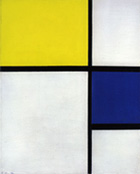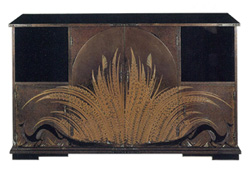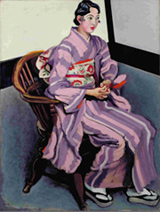Collection GalleryThe 6th Collection Gallery Exhibition 2016–2017 (142 works in all)
Collection Gallery
HOME > Collection Gallery > The 6th Collection Gallery Exhibition 2016–2017
The 6th Collection Gallery Exhibition 2016–2017 (142 works in all)
Exhibition Period
2. 15 (Wed.) – 4. 16 (Sun.), 2017
Overview
The last collection gallery exhibition of this fiscal year features both works from our core collection, and works we have acquired in recent years.
At the entrance to the collection gallery, entitled “Way to the Abstraction,” exhibits related to the special exhibition on the 3rd floor entitled “endless: The Paintings of YAMADA Masaaki” have been put on display. Known for his stripe paintings, Yamada Masaaki extracted forms and colors from objects such as bottles, bowls and fruits featured in his still life works, reconstructed and condensed them, and eventually reinvented them in abstract expressions as exemplified by his recurrent use of stripe-motifs. Transitional methods from concrete to abstract paintings vary from artist to artist, and this section features the transition of two painters, Piet Mondrian and Yoshihara Jiro. Mondrian reached his abstract expressions of color composition, which consist only of straight lines and three primary colors, starting from concrete expressions of groves, the shapes of trees, and waves on water surfaces. Yoshihara started from surrealist paintings where concrete objects are painted in a perspective of unconventional connections. He then went through a period of constructivism, and eventually came to create unique paintings in which, through intense, dynamic brushstrokes, he appears to have almost transformed the canvas itself into the embodiment of his thoughts.

- Piet MONDRIAN, Composition No. 1, 1929
The Japanese painting section features a retrospective of the late Fudo Shigeya, an avant-garde Japanese-style painter who passed away at the end of last year. Born on Awaji-shima Island in 1928, Fudo graduated from the Japanese Painting Course of Kyoto City Specialist School of Painting (present Kyoto City University of Arts) in 1948. In the same year, as a means of pursuing new expressions of art as well as a renewal of Japanese-style paintings, he established an artist group called “Pan Real” together with colleagues such as Mikami Makoto, Yamazaki Takashi, Hoshino Shingo and Yagi Kazuo. The following year, joined by such painters as Shimomura Ryonosuke and Ono Hidetaka, they established the Pan Real Art Association, consisting solely of graduates from the Japanese Painting Course of the art school. They held exhibitions every year, continually questioning the world with their work. (Fudo withdrew from the association in 1974.) The unique and unusual components he introduced into Japanese-style paintings, including constructive composition, abstract expressions, and uncommon materials such as cement, gravel and sawdust, are nothing but a challenge to conventional Japanese-style paintings in every aspect, and this exhibition explores his history of such brave challenges. At the same time, paintings featuring seasonal flowers such as camellia and plum blossoms are on display under the title “Early Spring Scenery in Japanese-style Painting.”
In the section entitled “Sea and Time in Contemporary Art,” we introduce an installation by Miyajima Tatsuo utilizing LED digital counters with flickering numbers as a continuation of the previous collection gallery exhibition. Moreover, Dominique Gonzalez-Foerster's DVD work entitled "De Novo" has also been put on display. Looking back on her past works which were submitted to, and exhibited at the Venetian Biennale, this particular work starkly describes the suffering that the artist experiences while creating her artwork. These two works, which suggest an inseparable relationship between thinking and time, seem to criticize modern society where people try to obtain answers immediately with the single click of a mouse.
The craft section features lacquer works we have acquired in recent years and ceramic works of Kawai Kanjiro. We explore a variety of expressions in the lacquer works, including Rokkaku Shisui's exact copy of the "Container for the Buddhist Text in Ninna-ji Temple," which is one of the most prominent maki-e lacquer works from the Heian period; a small chest designed by Kamisaka Sekka and produced by his brother, Yukichi, both of whom are associated with the Rinpa School of Art; a screen by Ban'ura Shogo, decorated in the art deco style which was fashionable in Western Europe during the 1920s; and Suzuki Masaya's "Interactive Forms" which bravely utilize lacquer on such modern materials as acrylic instead of wood. Furthermore, we have selected a number of representative works by Kawai Kanjiro, centering on his "Flat Vase of Grass and Flower Design" which won the Grand Prix at the Milano Triennale in 1957. All of his works featured in this collection gallery exhibition are from the same period.

- BAN'URA, Shogo, Shelf, Autumn Evening Design in maki-e, 1930
The western-style painting section features some of our masterpieces including Yasui Sotaro’s “Seated Woman” and Umehara Ryuzaburo’s “Tiantan in the Clouds.”

- YASUI, Sotaro, Seated Woman, 1930
In addition, prints by Hasegawa Kiyoshi, which are considered among the core works of our collections, have also been put on display after a long interval. One of the most interesting characteristics of our Hasegawa Kiyoshi Collection is that each sheet in this collection was carefully selected by the artist himself from several printing editions. This time, we have tried to include all of the scenery and still life motifs that he loved so well, and in addition focus on the excellence of each printing editions and the differences of expressions in the various print techniques. Indeed, the serene, poetic world of Hasegawa Kiyoshi has come to fruition in manière noire.
Themes of Exhibition
- ・Way to the Abstraction
- ・In Remembrance of FUDO Shigeya
- ・Early Spring Scenery in Japanese-style Painting
- ・Sea and Time in Contemporary Art
- ・Lacquer Works featuring Recent Acquisition
- ・Selected Works of KAWAI Kanjiro from the KAWAKATSU Collection
- ・Selected Works from Western-style Painting
- ・Poetic World of HASEGAWA Kiyoshi
- ・[Outside] Outdoor Sculptures


